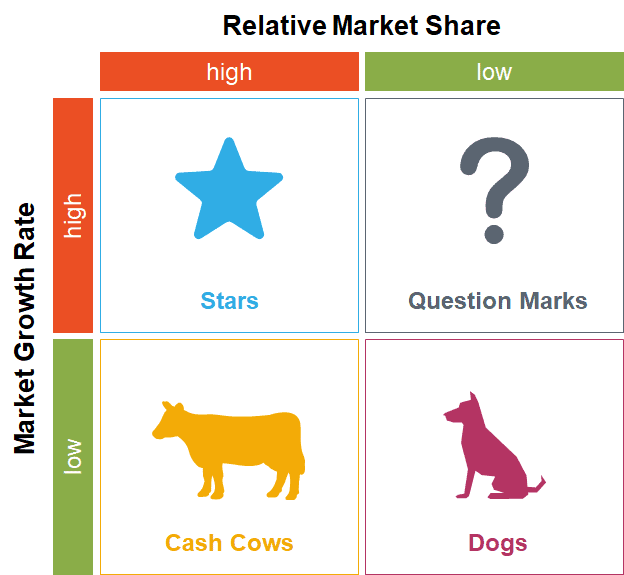BCG Growth-Share Matrix: The growth-share matrix was developed by Bruce Henderson, founder of The Boston Consulting Group, in 1970.
The X-axis takes the values of the Market share.
The Y-axis takes the values of Market Growth.
The matrix assumes that in times of market growth for a company it will consume Cash (resources) and in times of having a greater market share, it will generate more revenue (money/cash) for the company.
Based on these, companies can be classified as given in the following table depending on two parameters – The table also lists the treatment to be meted out to them.

| Type | Market share | Market growth | Remarks |
| Cash Cow | HIGH | LOW | Generates more cash based on the principle of the experience curve |
| Dog | LOW | LOW | Should be liquidated or repositioned |
| Question Mark | LOW | HIGH | Should be monitored frequently as they consume a lot of cash but don’t capture the market fast enough |
| Star | HIGH | HIGH | Stars, in the long run, become cash cows if the overall market stagnates. |
Stars:
Stars are business units that have a massive market share in a fast-growing industry.
Stars may also generate cash, however because of the rapidly growing market, those business units require non-stop investments.
Cash Cows:
Cash cows are business units with a massive market share in a mature and slow-growing industry.
Cash cows require little investment and generate cash that may be used to spend money on other business units
Question Marks:
This type of business unit is also called the problem child.
Question marks are business units with a low market share in a high-growth marketplace.
The organization needs to spend money on those organizations to grow its marketplace share, however, whether or not the investment will become a star (experience extended relative marketplace share) is unknown.
Dogs:
These business units have a small marketplace share in a mature industry.
A dog might not require sizeable cash, however, it ties up capital that would be invested elsewhere.
Unless a dog has some special strategic purposes, it has to be liquidated if there’s little potential to increase its marketplace share.